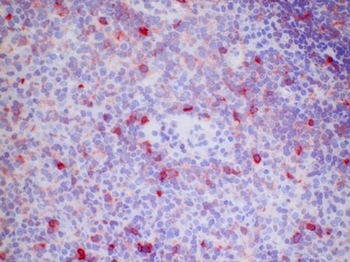TNFRSF1B Mouse Monoclonal Antibody [Clone ID: utr1]
Specifications
| Product Data | |
| Clone Name | utr1 |
| Applications | FC, FN, IHC, IP, WB |
| Recommended Dilution | Immunohistology: 2-5 µg/ml on Cryostat Sections (2% Periodate-lysine-paraformaldehyde or acetone for fixation). Flow Cytometry: 10 µg/ml. Immunoprecipitation. Western blots: 30 µg/ml on non-reduced SDS PAGE. The epitope is sensitive to reduction, may need enrichment by Immunoprecipitation. Functional Assay: This antibody utr1 is useful for studying biological effects of TNF-Receptor p75 in vitro where it inhibits the binding of radiolabelled TNF to Human cells expressing the p75 TNF receptor. In order to completely block TNF binding to the cell surface, 10 µg/ml of utr1 are required. utr1 itself may have an agonistic effect in assays measuring cytotoxicity, fibroblast growth or IL-6 secretion. Recommended Positive Control: Human Tonsil. |
| Reactivities | Human |
| Host | Mouse |
| Isotype | IgG1 |
| Clonality | Monoclonal |
| Immunogen | Partially purified preparations of TNF binding proteins from U937 cells. |
| Specificity | The antibody reacts with CD120b. Antigen Distribution Isolated Cells and Cell lines: U937, HL-60. Lymphocytes from peripheral blood show a faint staining. Mitogen stimulation of lymphocytes increases the intensity. Bone marrow cells are not stained with utr1. Tissue Sections: Immunohistochemical staining in normal not diseased tissue is confined to the lymphohistiocytic tissue, which includes the thymus and lymphoid organs such as spleen, tonsils, lymph nodes, mucosa, and associated lymphoid tissue (see Ref 7). Expression of p55 and p75 receptors can be detected in different areas where an overlapping is found betweenTNFR p75 and IL-2 receptor expression. The p75 expression can be detected mainly in the T-cell area whereas the p55 expression is restricted to dendritic reticulum cells in the germinal centers. In non lymphoid organs (kidney, liver, heart, brain, adrenals, uterus, ovary, testes, prostate, stomach, intestines) utr1 recognizes only in kidney some interstitial reticulum cells. Cells which are known to respond to TNF namely endothelial cells, smooth muscle cells and fibroblasts did not show expression of p55 and or p75 TNF receptor (see Ref 7). Investigations on pathological tissues show a TNFR p75 expression on epitheloid cell granulomas and giant cells in sarcoidosis. |
| Formulation | PBS, pH 7.2 State: Azide Free State: Liquid purified IgG fraction from Culture Supernatant Stabilizer: None Preservative: None |
| Concentration | 2.0 mg/ml (by Absorbanece at 280 nm) |
| Purification | Affinity Chromatography on Protein G |
| Storage | Upon receipt, store undiluted (in aliquots) at -20°C. Avoid repeated freezing and thawing. |
| Stability | Shelf life: one year from despatch. |
| Gene Name | tumor necrosis factor receptor superfamily member 1B |
| Database Link | |
| Background | Tumor Necrosis Factor (TNF) is a cytokine whose function is mediated through two distinct cell surface receptors (TNF Receptor I and TNF Receptor II) that are included in the TNF receptor superfamily along with FAS antigen and CD40. TNF receptors I and II are 55 and 75 kDa members, respectively, of a family of cell surface molecules including nerve growth factor receptor, Fas/Apo1, CD30, OX40, and 4-1BB, which are characterized by cysteine rich motifs in the extracellular domain. TNF Receptor II (p75, CD120b) is present on most cell types (including monocytes, endothelial cells, Langerhans cells, and macrophages) and is considered to play a role in cell stimulation by TNF alpha. TNF Receptor II molecule is shown to be responsible for stimulation of activated T lymphocytes by TNF alpha. |
| Synonyms | Tumor necrosis factor receptor 2, p80 TNF-alpha receptor, TNFRSF1B, TNFBR, TNF-R2 |
| Note | Protocol: Protocol with Frozen, ice-cold Acetone-Fixed Sections: The whole procedure is performed at room temperature 1. Wash in PBS 2. Block endogenous peroxidase 3. Wash in PBS 4. Block with 10% normal goat serum in PBS for 30min. in a humid chamber 5. Incubate with primary antibody (dilution see datasheet) for 1h in a humid chamber 6. Wash in PBS 7. Incubate with secondary antibody (peroxidase-conjugated goat anti mouse IgG+IgM (H+L) minimal-cross reaction to human) for 1h in a humid chamber 8. Wash in PBS 9. Incubate with AEC substrate (3-amino-9-ethylcarbazol) for 12min. 10. Wash in PBS 11. Counterstain with Mayer's hemalum Protocol with Formalin-Fixed, Paraffin-Embedded Sections: The whole procedure is performed at room temperature 1. Deparaffinize and rehydrate tissue section 2. Block endogenous peroxidase 3. Wash in PBS 4. Block with 10% normal goat serum in PBS for 30min. in a humid chamber 5. Incubate with primary antibody (dilution see datasheet) for 1h in a humid chamber 6. Wash in PBS 7. Incubate with secondary antibody (peroxidase-conjugated goat anti mouse IgG+IgM (H+L) minimal-cross reaction to human) for 1h in a humid chamber 8. Wash in PBS 9. Incubate with AEC substrate (3-amino-9-ethylcarbazol) for 12min. 10. Wash in PBS 11. Counterstain with Mayer's hemalum |
| Reference Data | |
Documents
| Product Manuals |
| FAQs |
{0} Product Review(s)
0 Product Review(s)
Submit review
Be the first one to submit a review
Product Citations
*Delivery time may vary from web posted schedule. Occasional delays may occur due to unforeseen
complexities in the preparation of your product. International customers may expect an additional 1-2 weeks
in shipping.






























































































































































































































































 Germany
Germany
 Japan
Japan
 United Kingdom
United Kingdom
 China
China



